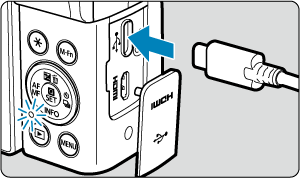Charging the Battery
- Using the Charger (Sold Separately) for Charging/Power
- Using the Battery Charger (Sold Separately) to Charge the Battery
-
Upon purchase, the battery is not fully charged.
Charge the battery before use.
-
Charge the battery on the day before or on the day it is to be used.
Charged batteries gradually lose their charge, even when they are not used.
-
Use the camera where the temperature is 0–35°C (32–95°F).
For optimal camera performance, use where the ambient temperature is 0–35°C (32–95°F). Lower temperatures may temporarily lower battery performance and reduce battery life. Higher temperatures may cause the camera body to become hot and prevent continuous use.
-
When not using the camera, remove the battery.
If the battery is left in the camera for a prolonged period, a small amount of power current will keep being released, resulting in excess discharge and shorter battery life. Store the battery with the protective cover attached. Storing the battery when it is fully charged may lower the battery performance.
Using the Charger (Sold Separately) for Charging/Power
You can use the Charger (sold separately) to Charging.
Charging
Supplying power
Although power is supplied to the camera when it is turned on, the battery is not charged. However, batteries are charged during auto power off.
The battery level indicator is gray when power is supplied.
To change from powering the camera to charging, turn the camera power off.
Caution
- Charging may stop if the camera becomes hot.
- Turn off the camera before removing the battery.
- Do not power the camera unless it has a Battery Pack LP-E17.
- To protect the battery pack and keep it in optimal condition, do not charge it continuously for more than 24 hours.
- If the charging lamp fails to light up or a problem occurs during charging (shown by the access lamp blinking in orange), unplug the power cord, reinsert the battery, and wait a few minutes before plugging it in again. If the problem persists, take the camera to the nearest Canon Service Center.
Note
- It is recommended that you use the USB Power Adapter PD-E2 or PD-E1 (sold separately) as a charger for this product.
- The PD-E2 and PD-E1 can also be used for powering.
- Some commercially available chargers have been confirmed to work with the camera. For details, check the Canon website ().
- Charging the camera when it is fully depleted takes approx. 2 hr. at room temperature (23°C/73°F).
- The time required to charge the battery will vary greatly depending on the ambient temperature and the battery's remaining capacity.
- For safety, charging in low temperatures (5–10°C/41–50°F) takes longer.
Using the Battery Charger (Sold Separately) to Charge the Battery
You can use the LC-E17 Series (LC-E17/LC-E17E/LC-E17C) battery chargers (sold separately) to charge the battery.
-
Detach the protective cover provided with the battery.
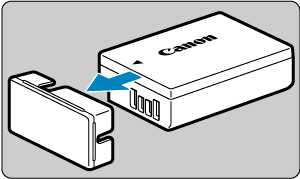
-
Fully insert the battery into the battery charger.
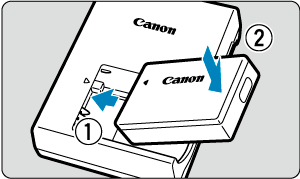
- Do the opposite to remove the battery.
-
Charge the battery.
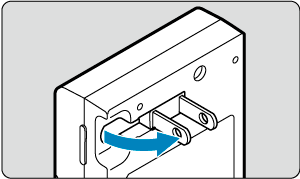
- Flip out the battery charger prongs in the direction shown and plug the charger into a power outlet.
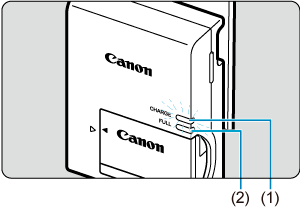
- Charging starts automatically and the charge lamp (1) lights up in orange.
- When the battery is fully charged, the full-charge lamp (2) will light up in green.
Caution
- After charging the battery, remove it and disconnect the charger from the power outlet.
- The battery charger can also be used in foreign countries. If necessary, attach a commercially available plug adapter for the respective country or region.
- To avoid damage to the battery charger, do not connect it to portable voltage transformers for overseas travel.
- After disconnecting the battery charger from the outlet, do not touch the prongs for approximately 5 seconds.
Note
- The battery charger is compatible with a 100 V AC to 240 V AC 50/60 Hz power source.
- It takes approx. 2 hr. to fully charge a completely exhausted battery at room temperature (23°C / 73°F).
- The time required to charge the battery will vary greatly depending on the ambient temperature and the battery's remaining capacity.
- For safety reasons, charging in low temperatures (5–10°C / 41–50°F) will take longer (up to approx. 4 hr.).
- If the battery becomes exhausted quickly even after having been fully charged, the battery has reached the end of its service life. Check the battery's recharge performance () and purchase a new battery.
